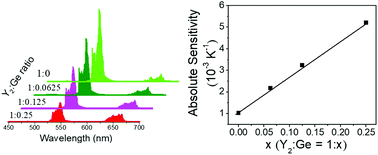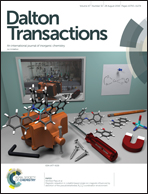Effect of doping Ge into Y2O3:Ho,Yb on the green-to-red emission ratio and temperature sensing
Abstract
A series of Ge-doped monophase Y2O3:Ho,Yb phosphor materials has been synthesized using solid state reactions. The addition of Ge to the Y2O3 host decreases the Ho green emission (5F4/5S2 → 5I8) and increases the red emission (5F5 → 5I8), providing a new means to tune the green-to-red emission intensity ratio. It is proposed that the Ge-induced multiphonon relaxation process enhances the transition from the intermediate state 5I6 to 5I7, which tunes the green and red emission intensities. Most importantly, with the addition of Ge, the non-thermally coupled Ho green and red emitting levels are associated together, and the red-to-green emission intensity ratio becomes sensitive to environmental temperature change. The absolute thermal sensitivity is enhanced by a factor of >5 times that in the absence of Ge. The matched green and red emission intensities, as well as the high thermal sensitivity, make Y2O3:Ho,Yb,Ge an ideal probe for optical temperature sensing at the single particle level in live biological samples. This study demonstrates a new mechanism to channel non-thermally coupled energy levels to achieve high temperature sensitivity.



 Please wait while we load your content...
Please wait while we load your content...